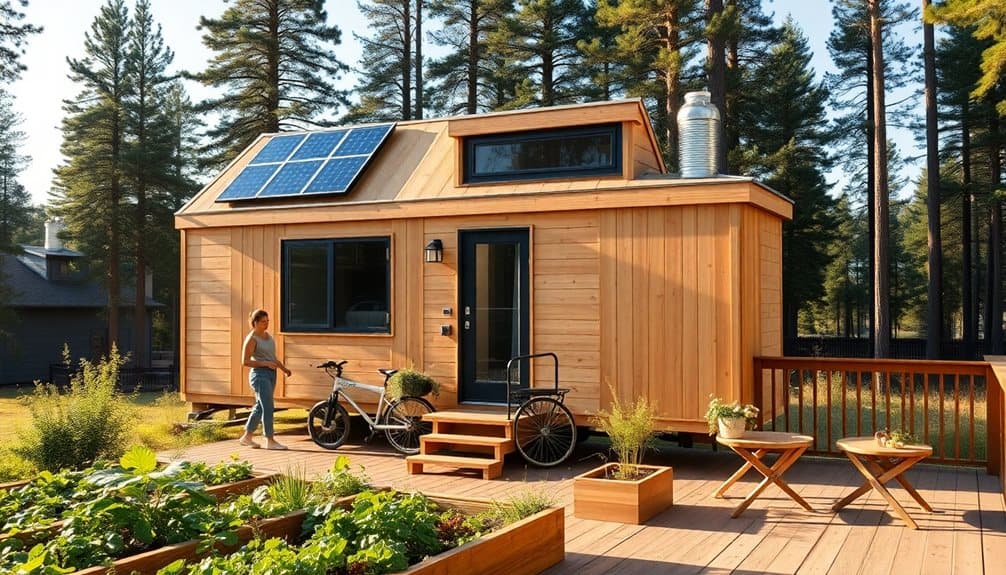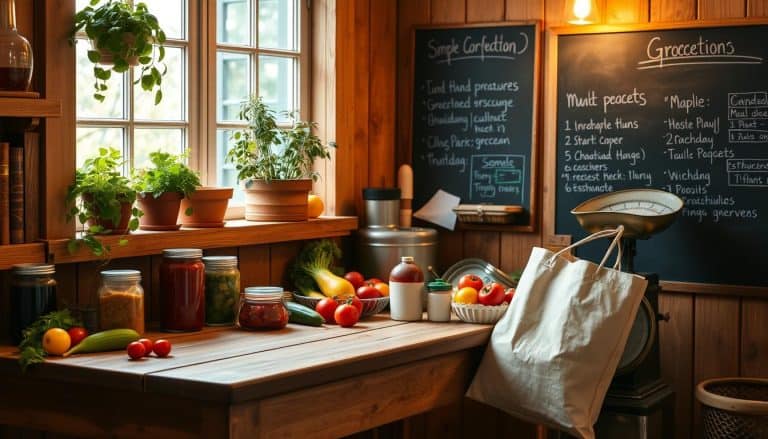This website contains affiliate links. Some products are gifted by the brand to test. As an Amazon Associate, I earn from qualifying purchases. The content on this website was created with the help of AI.
You’ll find endless ways to create an affordable outdoor oasis in 2024 while staying eco-conscious. Start with smart solar solutions like portable chargers and motion-sensor lights that cut electricity costs. Transform free shipping pallets into stylish furniture, and turn old containers into planters. Maximize your space with vertical gardens and multi-purpose storage solutions that double as seating. Save water with simple rainwater harvesting and drip irrigation systems. Combat pests naturally using herbs and kitchen ingredients. From seasonal strategies to upcycled decor, your sustainable outdoor sanctuary awaits with more money-saving innovations than ever before.
Key Takeaways
- Transform shipping pallets into outdoor furniture and planters, saving money while creating functional spaces with minimal investment.
- Install smart solar lighting solutions under $30 for pathway illumination and security, reducing long-term electricity costs.
- Implement rainwater harvesting systems and drip irrigation to cut water bills while maintaining a thriving garden.
- Use vertical gardening techniques with recycled materials to maximize space and grow food in limited areas.
- Practice natural pest control with herbs and kitchen ingredients instead of expensive chemical treatments.
Smart Solar Solutions

Solar power solutions don’t have to break the bank to make a significant impact on your outdoor living space. You can start small with portable solar chargers for your devices and gradually expand to solar-powered path lights, which typically cost under $30 per unit and provide reliable illumination for your walkways and garden areas.
Consider investing in solar-powered water features that run entirely off the sun’s energy. A basic solar fountain starts at around $75 and requires zero electrical hookup. For pest control, try solar-powered ultrasonic repellents – they’re maintenance-free and cost-effective alternatives to chemical solutions.
You’ll find excellent value in solar security lights with motion sensors. Mount them near entryways and dark corners to deter intruders while keeping your electricity bills low. Many models now include smart features like smartphone connectivity and adjustable sensitivity settings.
To maximize your investment, position solar panels or devices where they’ll receive 6-8 hours of direct sunlight daily. Clean your solar equipment monthly with water and a soft cloth to maintain peak efficiency. During winter months, adjust the angle of your panels to compensate for the sun’s lower position. For additional eco-friendly water management, pair your solar features with rain collection barrels that can store up to 60 gallons of water for garden irrigation.
Budget-Friendly DIY Outdoor Furniture
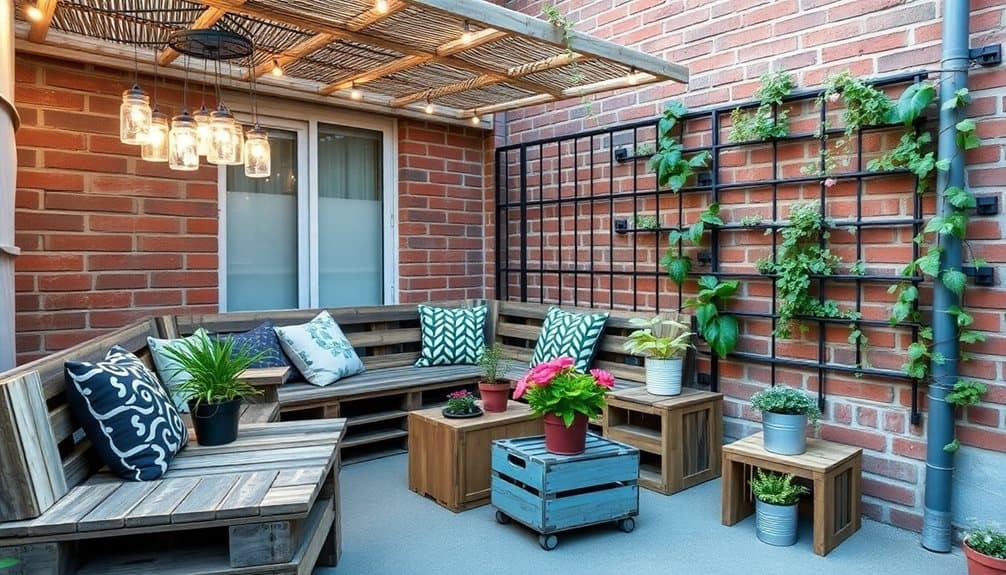
While harnessing the sun’s energy helps reduce costs outdoors, creating your own furniture can bring even more savings to your backyard setup. You’ll find that repurposed shipping pallets serve as the perfect foundation for outdoor sofas, coffee tables, and planters. Simply sand them down, treat them with weather-resistant sealant, and add cushions made from waterproof fabric.
Transform old metal drums into striking side tables by cleaning them thoroughly, applying rust-proof paint, and adding a reclaimed wood top. You can create sturdy benches using cinder blocks and pressure-treated lumber, requiring minimal tools and expertise. For dining solutions, convert an unused cable spool into a conversation-worthy table by sanding, staining, and sealing it.
Don’t overlook the potential of fallen tree segments, which you can turn into natural stools or side tables with basic tools. For vertical storage, mount recycled wooden crates on your fence or wall to display plants and store outdoor essentials. By choosing weather-resistant materials and applying proper sealants, your DIY outdoor furniture will withstand the elements while maintaining its eco-friendly appeal. With proper maintenance and protection from moisture, these outdoor furniture pieces can last 15-20 years, similar to wooden garden structures.
Vertical Garden Design

Limited outdoor space needn’t restrict your gardening ambitions when you can grow upward instead of outward. Vertical gardens maximize your growing area while minimizing your environmental footprint. You’ll find that repurposed materials like wooden pallets, mason jars, and rain gutters make excellent vertical planters without straining your budget.
Start by securing your chosen structure to a sturdy wall or fence that receives adequate sunlight. For pallet gardens, line the back with landscape fabric to retain soil and moisture. Install a drip irrigation system using recycled plastic bottles – simply punch small holes in the caps and hang them above your plants. You can also create a self-watering system by connecting several containers with cotton rope wicks.
Choose plants that thrive in vertical spaces: herbs like basil and mint, strawberries, lettuce, and trailing varieties of tomatoes. Stack plants strategically, placing sun-loving species at the top and shade-tolerant ones below. Maximize space efficiency by grouping plants with similar water needs together. Remember to leave enough room between rows for proper air circulation and maintenance access. Your vertical garden will provide fresh produce while transforming bare walls into living, green spaces.
Maintaining optimal humidity levels between 50-70% is crucial for healthy plant growth in your vertical garden setup.
Water Conservation Systems
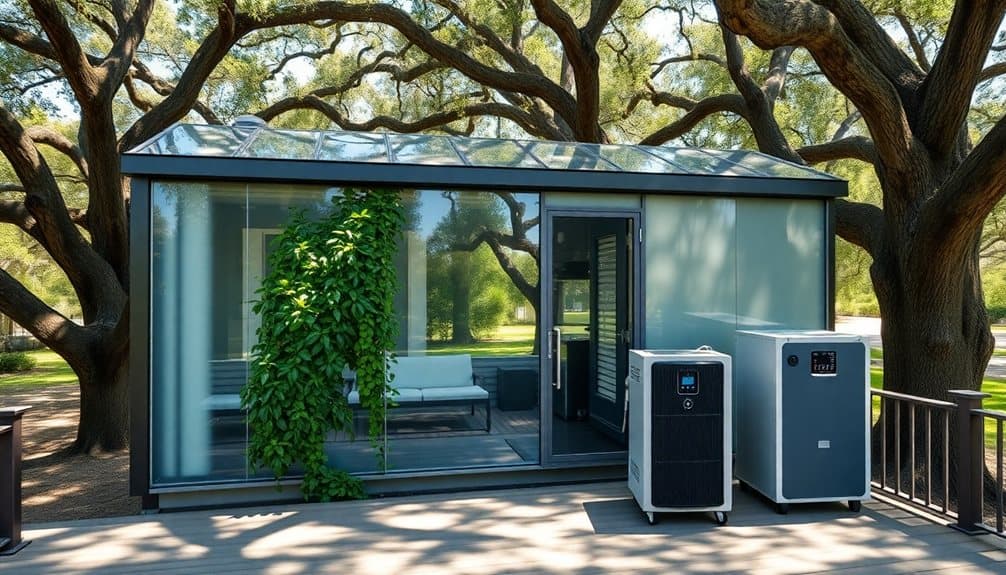
Every drop of water counts in sustainable outdoor living, and implementing smart conservation systems can slash your water usage while maintaining a thriving garden. Installing a rainwater harvesting system with interconnected barrels will capture free water for your plants. You’ll need gutters, downspouts, and food-grade containers with mesh filters to keep debris out.
Set up a drip irrigation system that delivers water directly to plant roots, reducing waste through evaporation. Connect it to your rain barrels using gravity feed, or add a small solar pump for consistent pressure. You’ll save up to 70% more water compared to traditional sprinklers.
Don’t overlook greywater recycling from your washing machine and kitchen sink. Install a simple diversion system that filters and routes this water to your garden beds. Use biodegradable, plant-friendly soaps to guarantee your greywater’s safety. Add moisture sensors and smart timers to automate your watering schedule based on weather conditions and soil moisture levels. Layer your soil with mulch to retain moisture and reduce watering frequency, creating a self-sustaining water cycle in your outdoor space. Quick connector technology enables secure and leak-free installation when setting up your irrigation system components.
Upcycled Decor Essentials
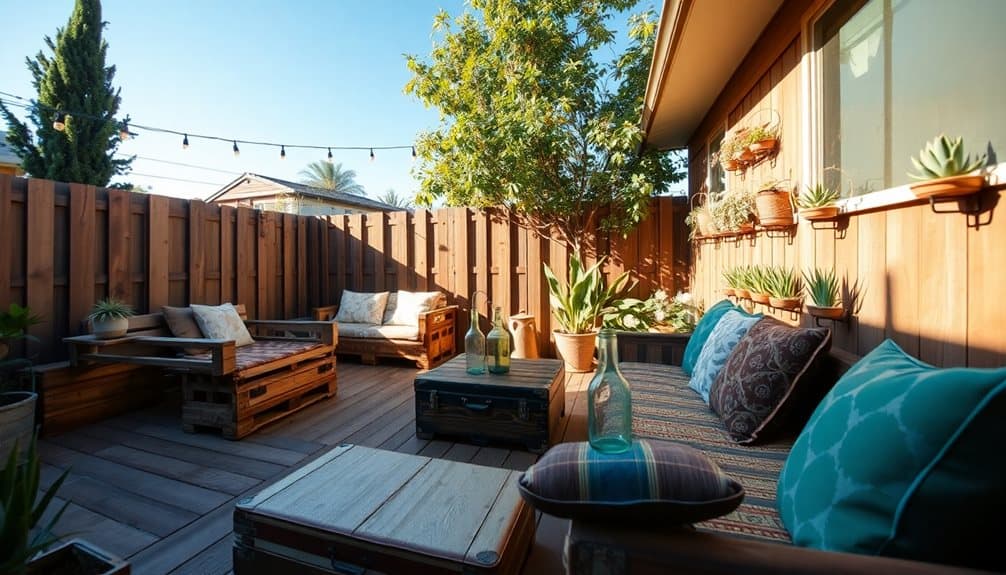
Creative upcycling transforms everyday discards into stunning outdoor decor that won’t strain your budget. By repurposing common household items, you’ll create unique pieces that reflect your style while reducing landfill waste. Look around your home, and you’ll find countless opportunities to turn ordinary objects into extraordinary outdoor accessories.
Start your upcycling journey with these impactful projects:
- Convert old wooden pallets into vertical gardens, hanging planters, or rustic coffee tables by sanding, treating, and painting them with weather-resistant finishes
- Transform glass jars into solar lanterns by adding solar-powered LED lights and wire hangers for atmospheric evening lighting
- Repurpose bicycle wheels into striking wall art by weaving colorful recycled rope or fabric through the spokes
- Turn discarded metal containers into modern planters with a coat of rust-resistant paint and strategic drainage holes
You’ll find that upcycling isn’t just about saving money; it’s about discovering the hidden potential in everyday items. Each piece tells a story and adds character to your outdoor space while promoting sustainable living. Remember to weatherproof your creations to guarantee they last through changing seasons. Consider using gardening bags to collect and organize materials as you gather items for your upcycling projects.
Small Space Optimization

Making the most of compact outdoor areas requires smart planning and versatile solutions. You’ll want to focus on vertical space by installing wall-mounted planters, hanging gardens, and fold-down tables that maximize your limited square footage. Consider multi-functional furniture pieces like storage benches or stackable seating that you can easily tuck away when not in use.
Transform narrow spaces by creating zones with portable dividers made from bamboo or reclaimed wood. Install a retractable awning or shade sail to define your space while providing weather protection. Use corner spaces efficiently by adding L-shaped seating or diagonal planting arrangements that don’t waste precious real estate.
Opt for container gardens with dwarf varieties and climbing plants that grow upward instead of outward. Install a space-saving rainwater collection system using slim-profile barrels that fit snugly against walls. Add mirrors strategically to create depth and reflect natural light, making your area feel more expansive. Consider modular designs that you can reconfigure based on your needs, such as wheeled plant stands or collapsible side tables that adapt to different occasions.
Multi-Purpose Outdoor Storage

Smart storage solutions work double duty in compact outdoor spaces. You’ll maximize your outdoor living area by choosing furniture and fixtures that serve multiple purposes while keeping your essentials organized and protected from the elements.
Transform your outdoor space with these resourceful storage options:
- Weather-resistant bench seating with hidden compartments for cushions, gardening tools, and outdoor games – crafted from sustainable bamboo or recycled plastic materials
- Vertical garden walls with integrated storage pockets for small tools, seeds, and plant care supplies, doubling as living privacy screens
- Modular cube storage units that function as side tables, plant stands, or extra seating while housing outdoor kitchen supplies and entertainment essentials
- Hollow decorative columns that cleverly conceal hoses, extension cords, and pool equipment while supporting hanging plants or lighting fixtures
You’ll want to invest in storage solutions that withstand weather conditions and complement your outdoor aesthetic. Choose items made from eco-friendly materials that’ll last for years, reducing waste and replacement costs. By selecting multi-functional pieces, you’ll create a clutter-free environment that maintains both practicality and style.
Natural Pest Control

Insects and unwanted critters don’t have to spoil your outdoor sanctuary. You can maintain a pest-free environment using natural solutions that won’t harm beneficial insects or your wallet. Start by planting pest-repelling herbs like lavender, mint, and citronella around your seating areas. These fragrant plants serve double duty as both decoration and natural deterrents.
Create barriers using coffee grounds, eggshells, or diatomaceous earth to keep slugs and crawling insects at bay. Hang bird feeders to attract natural predators that’ll help control mosquitoes and garden pests. For flying insects, install bat houses – a single bat can consume thousands of mosquitoes nightly.
You’ll find many pest-control ingredients right in your kitchen. Mix vinegar with water to spray around entry points, or use citrus peels and cinnamon to deter ants. Place copper tape around planters to prevent slug damage, and sprinkle cayenne pepper to keep mammals from digging in your garden beds. To manage wasps, hang fake nests – they’re territorial and won’t build near existing colonies. These chemical-free solutions protect your outdoor space while maintaining ecological balance and saving money on expensive pesticides.
Seasonal Money-Saving Strategies

While natural pest control helps protect your outdoor space year-round, each season brings unique opportunities to save money and maximize your outdoor living experience. By aligning your activities with nature’s cycles, you’ll reduce costs and environmental impact while enhancing your outdoor enjoyment.
In spring, start seedlings indoors using recycled containers and natural light. You’ll save considerably on mature plants while ensuring organic growing methods. Summer’s abundance lets you harvest and preserve herbs, vegetables, and flowers for year-round use, eliminating store-bought alternatives.
- Collect fallen leaves in autumn for free mulch and compost, protecting plants and enriching soil
- Store outdoor furniture and equipment properly in winter to extend their lifespan and avoid replacement costs
- Install rain barrels during wet seasons to capture free water for dry periods
- Practice seasonal maintenance like pruning and cleaning to prevent costly repairs
Take advantage of off-season sales to purchase outdoor equipment and furniture when demand is low. You’ll find the best deals on summer items during winter months, and vice versa. Remember to store seasonal items properly to prevent weather damage and extend their usefulness.
Frequently Asked Questions
How Do Local HOA Regulations Affect Outdoor Living Space Modifications?
Your HOA’s regulations can greatly impact your outdoor modifications. You’ll need to check specific rules about landscaping, deck construction, pergolas, and other structures before starting any project. Common restrictions include height limits, material requirements, and setback distances. Always get written approval from your HOA board to avoid fines or forced removal. Consider joining the HOA board to help shape future-friendly outdoor living policies.
What Insurance Considerations Should I Have for My Outdoor Living Area?
Over 40% of outdoor living space claims involve weather-related damage. You’ll need to update your homeowner’s insurance to cover your outdoor features, including furniture, grills, and built-in structures. Consider adding specific riders for natural disasters common in your area. Don’t forget liability coverage if you’re hosting guests. Using sustainable, weather-resistant materials can help reduce your premiums and protect your investment while minimizing environmental impact.
Can Outdoor Living Spaces Increase My Property Taxes?
Your outdoor living improvements can increase your property’s assessed value, which may lead to higher property taxes. You’ll want to check with your local tax assessor’s office, as regulations vary by location. Keep in mind that simple, sustainable additions like container gardens or permeable patios often have minimal tax impact compared to permanent structures. Consider using recycled materials and natural elements to create value while maintaining a lighter tax footprint.
Which Outdoor Living Improvements Offer the Best Return on Investment?
You’ll get the best ROI from a well-designed deck or patio, typically returning 60-80% of your investment. Low-maintenance native landscaping and sustainable hardscaping also add significant value while reducing water costs. Consider installing a modest outdoor kitchen or fire pit using reclaimed materials. Smart lighting with LED fixtures and solar-powered options both enhance ambiance and save energy while boosting property appeal.
How Do Weather Patterns Affect Outdoor Living Space Durability?
Weather takes a major toll on your outdoor spaces through UV damage, moisture cycles, and temperature fluctuations. You’ll notice sun fading on furniture, warping of wooden structures during wet seasons, and cracking in materials from freeze-thaw cycles. To protect your investment, choose weather-resistant materials like recycled composites, apply eco-friendly sealants regularly, and create proper drainage to prevent water damage.

